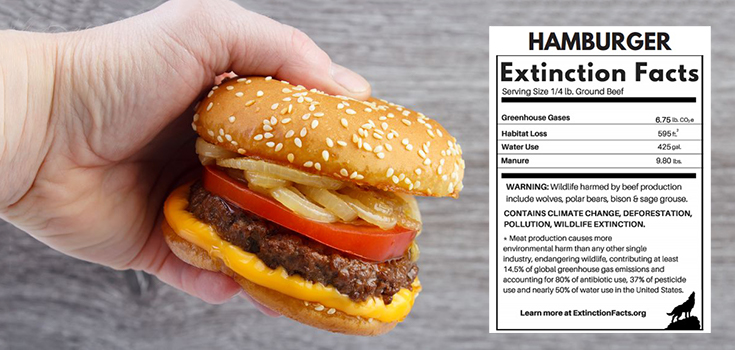Interesting Meat Labels Tell You How Meat Impacts Environment
Interesting Meat Labels Tell You How Meat Impacts Environment
While the government is redesigning nutrition labels, the Center for Biological Diversity is using the momentum to help make the public aware of the potential damage being done to the environment and wildlife by consuming meat products.
While the government is redesigning nutrition labels, the Center for Biological Diversity is using the momentum to help make the public aware of the potential damage being done to the environment and wildlife by consuming meat products. Surprisingly, the labels don’t just discuss the animal you’re eating, but also many other animals that are harmed in the process of deforestation that factory farming requires to sustain itself.
Dr. Jennifer Molidor, senior food campaigner for the Center for Biological Diversity,:
“Meat production is one of the single most destructive industries on the planet, and our diets are putting enormous pressure on wild species who are already in harm’s way.”
Although it has been conditioned into most of us that eating meat is a way of life, the Center for Biological Diversity hopes to make people question their choices, not only for humane reasons, but because of the impact on the environment.
These labels will not only tell you what wildlife you are harming by continuing to purchase and consume specific meat products, but also how much water was wasted, an estimation of greenhouse gas emission and how many habitats were lost in the production.
For example, four slices of bacon not only cost the life of the pig in question, but also emits 3.03 lbs of carbon dioxide, accounts for a habitat loss of 30.2 square feet and accounts for 165 gallons of water usage. It also brings awareness that other animals harmed in pork production can include the Indiana bat, whooping crane, copper-belly water snake and the black-footed ferret.
So far, the organization has created labels for the production of bacon, chicken breast and ground beef, three of the most popular items of consumption.
Dr. Jennifer Molidor states that she procured the statistics from doing her own research with her team, but also by using the USDA’s own reports on animal agriculture.
The group has also created a website called Take Extinction off Your Platethat allows users to get more information on animal agriculture and animal and extinction friendly recipes.
| About Anna Scanlon: | |
| Anna Scanlon is an author of YA and historical fiction and a PhD student at the University of Leicester where she is finishing her degree in modern history. You can find out more about Anna and her books on her lifestyle blog annainwonderland.co.uk. | |
Other Popular Stories:


Post a Comment